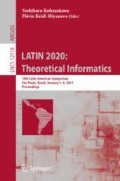Abstract
A lattice animal is a connected set of cells on a lattice. The perimeter of a lattice animal A consists of all the cells that do not belong to A, but that have a least one neighboring cell of A. We consider minimal-perimeter lattice animals, that is, animals whose periemeter is minimal for all animals of the same area, and provide a set of conditions that are sufficient for a lattice to have the property that inflating all minimal-perimeter animals of a certain size yields (without repetitions) all minimal-perimeter animals of a new, larger size. We demonstrate this result for polyhexes (animals on the two-dimensional hexagonal lattice).
Access this chapter
Tax calculation will be finalised at checkout
Purchases are for personal use only
References
Altshuler, Y., Yanovsky, V., Vainsencher, D., Wagner, I.A., Bruckstein, A.M.: On minimal perimeter polyminoes. In: Kuba, A., Nyúl, L.G., Palágyi, K. (eds.) DGCI 2006. LNCS, vol. 4245, pp. 17–28. Springer, Heidelberg (2006). https://doi.org/10.1007/11907350_2
Asinowski, A., Barequet, G., Zheng, Y.: Enumerating polyominoes with fixed perimeter defect. In: Proceedings of the 9th European Conference on Combinatorics, Graph Theory, and Applications, Vienna, Austria, vol. 61, pp. 61–67. Elsevier (2017)
Asinowski, A., Barequet, G., Zheng, Y.: Polycubes with small perimeter defect. In: Proceedings of the 29th Annual ACM-SIAM Symposium on Discrete Algorithms, New Orleans, LA, pp. 93–100, January 2018
Barequet, G., Ben-Shachar, G.: Properties of minimal-perimeter polyominoes. In: Wang, L., Zhu, D. (eds.) COCOON 2018. LNCS, vol. 10976, pp. 120–129. Springer, Cham (2018). https://doi.org/10.1007/978-3-319-94776-1_11
Barequet, G., Ben-Shachar, G.: Minimal-perimeter polyominoes: chains, roots, and algorithms. In: Pal, S.P., Vijayakumar, A. (eds.) CALDAM 2019. LNCS, vol. 11394, pp. 109–123. Springer, Cham (2019). https://doi.org/10.1007/978-3-030-11509-8_10
Brunvoll, J., Cyvin, S.: What do we know about the numbers of benzenoid isomers? Zeitschrift für Naturforschung A 45(1), 69–80 (1990)
Cyvin, S.J., Brunvoll, J.: Series of benzenoid hydrocarbons with a constant number of isomers. Chem. Phys. Lett. 176(5), 413–416 (1991)
Dias, J.: New general formulations for constant-isomer series of polycyclic benzenoids. Polycyclic Aromat. Compd. 30, 1–8 (2010)
Dias, J.: Handbook of Polycyclic Dydrocarbons. Part A: Benzenoid Hydrocarbons. Elsevier, New York (1987)
Eden, M.: A two-dimensional growth process. In: Neyman, J. (ed.) Proceedings of the 4th Berkeley Symposium on Mathematical Statistics and Probability, vol. 4, pp. 223–239 (1961)
Fülep, G., Sieben, N.: Polyiamonds and polyhexes with minimum site-perimeter and achievement games. Electron. J. Comb. 17(1), 65 (2010)
Harary, F., Harborth, H.: Extremal animals. J. Comb. Inf. Syst. Sci. 1(1), 1–8 (1976)
Jensen, I., Guttmann, A.: Statistics of lattice animals (polyominoes) and polygons. J. Phys. A: Math. General 33(29), L257 (2000)
Mertens, S.: Lattice animals: a fast enumeration algorithm and new perimeter polynomials. J. Stat. Phys. 58(5), 1095–1108 (1990)
Redelmeier, D.H.: Counting polyominoes: yet another attack. Discret. Math. 36(2), 191–203 (1981)
Sieben, N.: Polyominoes with minimum site-perimeter and full set achievement games. Eur. J. Comb. 29(1), 108–117 (2008)
Temperley, H.: Combinatorial problems suggested by the statistical mechanics of domains and of rubber-like molecules. Phys. Rev. 103(1), 1 (1956)
Vainsencher, D., Bruckstein, A.M.: On isoperimetrically optimal polyforms. Theor. Comput. Sci. 406(1–2), 146–159 (2008)
Wang, D.L., Wang, P.: Discrete isoperimetric problems. SIAM J. Appl. Math. 32(4), 860–870 (1977)
Author information
Authors and Affiliations
Corresponding author
Editor information
Editors and Affiliations
Rights and permissions
Copyright information
© 2020 Springer Nature Switzerland AG
About this paper
Cite this paper
Barequet, G., Ben-Shachar, G. (2020). On Minimal-Perimeter Lattice Animals. In: Kohayakawa, Y., Miyazawa, F.K. (eds) LATIN 2020: Theoretical Informatics. LATIN 2021. Lecture Notes in Computer Science(), vol 12118. Springer, Cham. https://doi.org/10.1007/978-3-030-61792-9_41
Download citation
DOI: https://doi.org/10.1007/978-3-030-61792-9_41
Published:
Publisher Name: Springer, Cham
Print ISBN: 978-3-030-61791-2
Online ISBN: 978-3-030-61792-9
eBook Packages: Computer ScienceComputer Science (R0)

